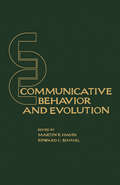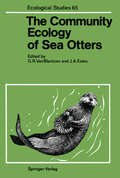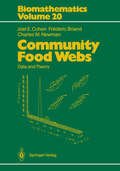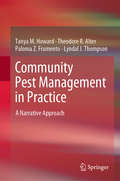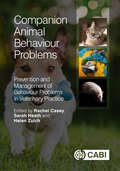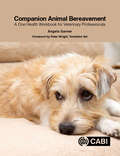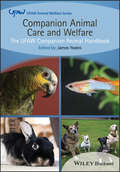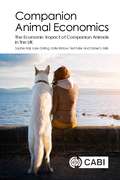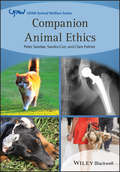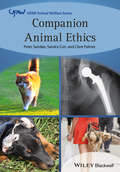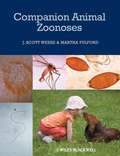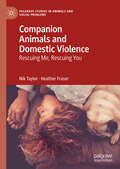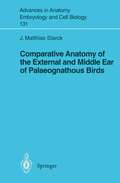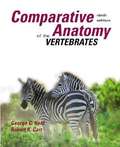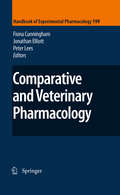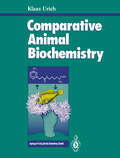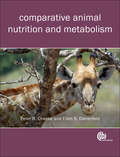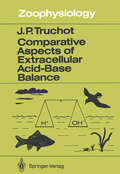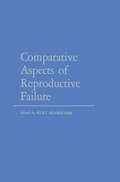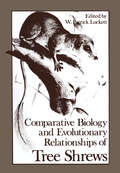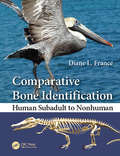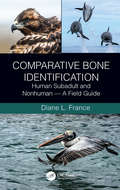- Table View
- List View
Communicative Behavior and Evolution
by Martin E. Hahn Edward C. SimmelCommunicative Behavior and Evolution presents the selected works of experts from different scientific disciplines that investigate the evolution of communicative behavior. The book is composed of papers that study communicative behavior of humans and of different kinds of animals. The text contains articles that discuss attempts in the study of behavioral evolution; communication and human language; the behavior-genetic approach; systems approach to genetic and selection mechanisms; investigation of interspecific communication; and learned language in chimpanzees. Zoologists, ethologists, behavioral geneticists, and psychologists will find this book highly interesting.
The Community Ecology of Sea Otters (Ecological Studies #65)
by Glenn R. VanBlaricom James A. EstesThe impetus for this volume comes from two sources. The first is scientific: by virtue of a preference for certain large benthic invertebrates as food, sea otters have interesting and significant effects on the structure and dynamics of nearshore communities in the North Pacific. The second is political: be cause of the precarious status of the sea otter population in coastal California, the U.S. Fish and Wildlife Service (USFWS) announced, in June 1984, a proposal to establish a new population of sea otters at San Nicolas Island, off southern California. The proposal is based on the premise that risks of catastrophic losses of sea otters, due to large oil spills, are greatly reduced by distributing the population among two geographically separate locations. The federal laws of the U.S. require that USFWS publish an Environmental Impact Statement (ElS) regarding the proposed translocation of sea otters to San Nicolas Island. The EIS is intended to be an assessment of likely bio logical, social, and economic effects of the proposal. In final form, the EIS has an important role in the decision of federal management authority (in this case, the Secretary of the Interior of the U.S.) to accept or reject the proposal.
Community Food Webs: Data and Theory (Biomathematics #20)
by Joel E. Cohen Frederic Briand Charles M. NewmanFood webs hold a central place in ecology. They describe which organisms feed on which others in natural habitats. This book describes recently discovered empirical regularities in real food webs: it proposes a novel theory unifying many of these regularities, as well as extensive empirical data. After a general introduction, reviewing the empirical and theoretical discoveries about food webs, the second portion of the book shows that community food webs obey several striking phenomenological regularities. Some of these unify, regardless of habitat. Others differentiate, showing that habitat significantly influences structure. The third portion of the book presents a theoretical analysis of some of the unifying empirical regularities. The fourth portion of the book presents 13 community food webs. Collected from scattered sources and carefully edited, they are the empirical basis for the results in the volume. The largest available set of data on community food webs provides a valuable foundation for future studies of community food webs. The book is intended for graduate students, teachers and researchers primarily in ecology. The theoretical portions of the book provide materials useful to teachers of applied combinatorics, in particular, random graphs. Researchers in random graphs will find here unsolved mathematical problems.
Community Pest Management in Practice: A Narrative Approach
by Tanya M. Howard Theodore R. Alter Paloma Z. Frumento Lyndal J. ThompsonThis book presents a collection of practitioner and community stories that reveal how invasive species management is a community issue that can spark community formation and collective action. It combines the unique first-person narratives of practitioners on the frontline of invasive species management in Australia with three case studies of community action for wild dog management across a range of geographical landscapes. The book offers readers a new understanding of how communities are formed in the context of managing different species, and how fundamental social and political processes can make or break landholders’ ability to manage invasive species. Using narrative analysis of practitioner profiles and community groups, drawing lessons from real-world practices, and employing theories from community development, rural sociology and collective action, this book serves multiple functions: it offers a teaching tool, a valuable research contribution, and a practitioner’s field guide to pursuing effective community development work in connection with natural resource management, wildlife management and environmental governance.
Companion Animal Behaviour Problems: Prevention and Management of Behaviour Problems in Veterinary Practice
by David Ryan Jon Bowen Emma Lightfoot Dr Anne McBride Clare Wilson Caroline Bower Francesca Riccomini Claire Hargrave David Appleby Emily Blackwell Julie Bedford Caroline Warnes Trudi Atkinson Emma Brown Amanda Roshier Stephanie HedgesBehaviour problems are a significant cause of companion animal relinquishment and euthanasia. This book provides up to date information about animal behaviour as well as practical advice on how veterinary practice professionals can manage undesirable animal behaviour and give down to earth, appropriate and trusted advice to owners. This book: · Covers the important aspects of behaviour in dogs, cats, rabbits and rodents, parrots and birds, as well as how this behaviour has adapted to the domestic environment. · Discusses the role of the veterinary practice in improving the emotional experience of animals attending the veterinary practice, including practice design, socialisation classes for young animals and effective communication with owners. · Covers the clinical decision-making process in managing the signs of undesirable behaviour, appropriately handling pets in the practice to minimise distress, as well as: behavioural first aid, referral to a specialist, medical influences on behaviour and decisions about euthanasia. This practical and accessible book gives all the essential information needed by veterinary professionals in order to advise clients on the behaviour and well-being of animals in their care.
Companion Animal Bereavement: A One Health Workbook for Veterinary Professionals
by Angela GarnerThis concise workbook is written as a guide for veterinary professionals to support owners through the many challenges they face before, during and after the death of their companion animal. This unique text provides a wealth of practical advice to be used when supporting both adults and children through the grief process. It offers support when discussing subjects such as natural death versus euthanasia and guiding owners through after death services. Also, it covers the difficulties experienced by owners due to separation for other reasons, such as when a pet has to be rehomed. The book: - Gives highly practical guidance on pet bereavement support for vet staff before, during and after animal loss, including communicating with highly distressed people; - Includes exercises and activities which can be downloaded and shared with owners to help them cope with the destabilising effects of grief; - Helps gain a deeper understanding of the owners' perceptions of the process, including their fears and feelings; - Addresses the importance of self-care and peer support within the veterinary team or animal welfare organisation; - Contains numerous case studies and practical examples in the book and via additional online resources.
Companion Animal Care and Welfare: The UFAW Companion Animal Handbook (Wiley-ASME Press Series)
by James YeatesCompanion Animal Care and Welfare: The UFAW Companion Animal Handbook presents a comprehensive, accessible and practical reference for all parties seeking information about the proper care of companion animals. Identifies the needs of companion animals, explains how we know these needs, and gives scientifically-backed advice on how to meet these needs Promotes the most humane treatment and best possible care of our companion animals Addresses controversial issues such as selective breeding, companion animal showing, the keeping of exotic species, and the international pet trade Covers the husbandry and care of all major companion animal species, including mammals, birds, fish, reptiles and amphibians
Companion Animal Care and Welfare: The UFAW Companion Animal Handbook (UFAW Animal Welfare)
by James YeatesCompanion Animal Care and Welfare: The UFAW Companion Animal Handbook presents a comprehensive, accessible and practical reference for all parties seeking information about the proper care of companion animals. Identifies the needs of companion animals, explains how we know these needs, and gives scientifically-backed advice on how to meet these needs Promotes the most humane treatment and best possible care of our companion animals Addresses controversial issues such as selective breeding, companion animal showing, the keeping of exotic species, and the international pet trade Covers the husbandry and care of all major companion animal species, including mammals, birds, fish, reptiles and amphibians
Companion Animal Economics: The Economic Impact of Companion Animals in the UK (CABI Concise)
by Dr Sophie S Hall Luke Dolling Katie Bristow Professor Ted Fuller Professor Daniel MillsSuccinct, highly readable and thought provoking, this important new text is designed to raise awareness of the potential economic impact of companion animals in the UK. It discusses the potential benefits and costs of companion animals to the economy and highlights the need for this matter to be thoroughly researched, given the potential scale of impact and the potential costs of ignoring this matter. The book includes: - case studies to illustrate the savings to the NHS that might be associated with companion animal ownership; - links to up-to-date tables and content that might form templates for use in other countries; and - highly readable information written by expert authors and key opinion leaders in the field. Inspired by the seminal Council for Science and Society (CSS) Report, Companion Animals in Society (1988), this work updates and extends its evaluation of the economic impact of companion animals on society and lays a benchmark for future development. This pivotal new book is important for policy makers at national and international levels and all those involved in animal welfare.
Companion Animal Ethics (UFAW Animal Welfare)
by Peter Sandøe Sandra Corr Clare PalmerCompanion Animal Ethics explores the important ethical questions and problems that arise as a result of humans keeping animals as companions. The first comprehensive book dedicated to ethical and welfare concerns surrounding companion animals Scholarly but still written in an accessible and engaging style Considers the idea of animal companionship and why it should matter ethically Explores problems associated with animals sharing human lifestyles and homes, such as obesity, behavior issues, selective breeding, over-treatment, abandonment, euthanasia and environmental impacts Offers insights into practical ways of improving ethical standards relating to animal companions
Companion Animal Ethics (UFAW Animal Welfare)
by Peter Sandøe Sandra Corr Clare PalmerCompanion Animal Ethics explores the important ethical questions and problems that arise as a result of humans keeping animals as companions. The first comprehensive book dedicated to ethical and welfare concerns surrounding companion animals Scholarly but still written in an accessible and engaging style Considers the idea of animal companionship and why it should matter ethically Explores problems associated with animals sharing human lifestyles and homes, such as obesity, behavior issues, selective breeding, over-treatment, abandonment, euthanasia and environmental impacts Offers insights into practical ways of improving ethical standards relating to animal companions
Companion Animal Zoonoses
by J. Scott Weese Martha FulfordCompanion Animal Zoonoses is a comprehensive resource on diseases transmissible between animals and humans. Presenting detailed prevention and control strategies for zoonotic diseases, the book is an in-depth guide to practical information on the spread of disease between pet animals and humans. This relevant work provides up-to-date information on emerging issues, disease incidence and risk, and management measures. Covering the complete range of companion animal zoonoses, each topic begins with information on etiology, geographic distribution, epidemiology, and pathophysiology. The discussion then moves into clinical presentation, diagnosis, and management, alongside prevention information for both animals and humans. Companion Animal Zoonoses is an essential reference for practicing veterinarians, public health veterinarians, and veterinary students. It will also appeal to physicians who wish to better understand zoonotic diseases.
Companion Animals and Domestic Violence: Rescuing Me, Rescuing You (Palgrave Studies in Animals and Social Problems)
by Nik Taylor Heather FraserIn this book, Nik Taylor and Heather Fraser consider how we might better understand human-animal companionship in the context of domestic violence. The authors advocate an intersectional feminist understanding, drawing on a variety of data from numerous projects they have conducted with people, about their companion animals and links between domestic violence and animal abuse, arguing for a new understanding that enables animals to be constituted as victims of domestic violence in their own right. The chapters analyse the mutual, loving connections that can be formed across species, and in households where there is domestic violence. Companion Animals and Domestic Violence also speaks to the potentially soothing, healing and recovery oriented aspects of human-companion animal relationships before, during and after the violence, and will be of interest to various academic disciplines including social work, anthropology, sociology, philosophy, geography, as well as to professionals working in domestic violence or animal welfare service provision.
Comparative Anatomy of the External and Middle Ear of Palaeognathous Birds (Advances in Anatomy, Embryology and Cell Biology #131)
by J.Matthias StarckComparative Anatomy Of The Vertebrates (PDF)
by George C. Kent Robert K. CarrDeemed a classic for its reading level and high-quality illustrations, this respected text is ideal for your one-semester Comparative Anatomy course. For the ninth edition, George Kent is joined by new co-author Bob Carr.
Comparative and Veterinary Pharmacology (Handbook of Experimental Pharmacology #199)
by Fiona Cunningham Jonathan Elliott Peter LeesThe human–animal bond has evolved and diversi?ed down the ages. Dogs, cats and even horses, have long ful?lled the role of faithful companion and indeed, as exempli?ed by the introduction of seeing and hearing dogs, there may be a critical level of co-dependency between the species. In the twenty-?rst century, the animal types that are kept as pets in many parts of the world are extensive ranging from reptiles through rodents to ruminants and beyond. As would be predicted by the nature of the relationship, the approach to treatment of a companion animal is often closely aligned to that which would have been offered to their owner. However, an increasing awareness of welfare issues, such as the recognition that animals expe- ence pain and the proven bene?ts of disease prevention in intensive farming units, together with the growth in zoos and wildlife parks, has increased the likelihood of food producing and non-domesticated animals receiving medicinal products during their life-time. Although many of the individual drugs or classes of drugs administered to animals are the same as, or derived from, those given to man, the safe and effective use of drugs in animals often cannot be achieved by simply transposing knowledge of drug action on, or behaviour in, the body from one species to another. The impact of the anatomical, physiological and pathophysiological variability that spans the animal kingdom can often profoundly alter drug response.
Comparative Animal Biochemistry
by Klaus Urichtribute greatly to understanding the origins of The plan for this book goes back almost 20 years. Already, at that time, it was possible to recognize organisms. an extraordinary variation in metabolites and To provide the biochemist with a ready over processes superimposed upon the basic biochem view of the structural diversity of animals, the book includes a simplified version of animal sys ical system of animals. Each species, each indi tematics; for further information on the classifica vidual, in fact each type of cell of the multicellu lar organism possesses its own biochemical char tion, structure and life of particular animal spe acter, and this molecular variety, its biological sig cies, the reader should consult the relevant text nificance, and its evolutionary development books. It is assumed that the zoologist reader has throw up many interesting questions. The com a basic knowledge of biochemistry; important general biochemical facts are in any case given for parative approach that has been so productive at many of the subjects covered. the higher levels of complexity of morphology and physiology can also be used to great effect at I had already completed several chapters of the molecular level. this book by the beginning of the 1970s.
Comparative Animal Nutrition and Metabolism
by Peter Cheeke Ellen DierenfeldNutrition is a very broad discipline, encompassing biochemistry, physiology, endocrinology, immunology, microbiology and pathology. Presenting the major principles of nutrition of both domestic and wild animals, this book takes a comparative approach, recognising that there are considerable differences in nutrient digestion, metabolism and requirements among various mammalian and avian species. Explaining species differences in food selection, food-seeking and digestive strategies and their significance to nutritional needs, chapters cover a broad range of topics including digestive physiology, metabolic disorders and specific nutrients such as carbohydrates proteins and lipids, with particular attention being paid to nutritional and metabolic idiosyncrasies. It is an essential text for students of animal and veterinary sciences.
Comparative Animal Nutrition and Metabolism (PDF)
by Peter Cheeke Ellen DierenfeldNutrition is a very broad discipline, encompassing biochemistry, physiology, endocrinology, immunology, microbiology and pathology. Presenting the major principles of nutrition of both domestic and wild animals, this book takes a comparative approach, recognising that there are considerable differences in nutrient digestion, metabolism and requirements among various mammalian and avian species. Explaining species differences in food selection, food-seeking and digestive strategies and their significance to nutritional needs, chapters cover a broad range of topics including digestive physiology, metabolic disorders and specific nutrients such as carbohydrates proteins and lipids, with particular attention being paid to nutritional and metabolic idiosyncrasies. It is an essential text for students of animal and veterinary sciences.
Comparative Aspects of Extracellular Acid-Base Balance (Zoophysiology #20)
by Jean-Paul TruchotInterest in comparative acid-base physiology has considerably grown during last decades even in the absence of major technical or conceptual advances. This is firstly because it has become clear that the extracellular acid-base state reflects the performance of many exchange functions at the organism level: respiration and ventilation of the gas exchange surfaces, metab olism, iono-and osmoregulation. Such functions are much in fluenced by ambient conditions, and the measurement of acid base parameters thus provides useful information about the organism's responses to environmental challenges. Secondly, many processes at the molecular level are now known to be pH sensitive, and acid-base regulation thus appears to be a major requirement for the functional integrity of cells and organisms. How extracellular acid-base balance can be maintained in a wide variety of animals living in different conditions is the sub ject of this book. The approach is comparative and environ mental throughout. All body fluids share similar buffer proper ties, and common physicochemical principles apply to any acid base system. However, in accord with differing designs and con straints along animal evolution, varying effector organs and mechanisms are at work to maintain an appropriate acid-base state in the organism. Particular emphasis is placed on the fun damental differences between water and air breathers and on the acid-base and respiratory problems arising at the transition from an aquatic to a terrestrial life. Also the complex array of factors influencing the acid-base state in water-dwelling animals is thoroughly discussed.
Comparative Aspects of Reproductive Failure: An International Conference at Dartmouth Medical School, Hanover, N.H.—July 25–29, 1966
by K. BenirschkeTo many, the contents of this conference may not seem appropriate at a time when the minds are preoccupied with a "population explosion." To the participants and guests of this conference, however, this was a week of fascinating discussions. While quantitative aspects of reproduc tion were touched upon, it was mostly a search for an understanding of the qualitative aspects of reproduction and its failure. Only when we understand these more completely will it be possible to render optimum care and have the foundations for meaningful population control. The conference was conceived in discussions at the Committee on Pathology of the National Academy of Sciences, W"ashington, in 1965. It was felt that investigators in medicine and the veterinary fields would profit greatly from a closer liaison. All too frequently, we work relatively isolated in our respective fields and, with the burgeoning information filling our journals, we have not enough time and leisure to stand back and attempt a comparative look at the subject of study. Often we are not familiar with the techniques other disciplines use, and which we could well employ to great advantage. ,,yhile this applies to many aspects of medicine, a comparative approach to the study of reproductive failure seemed most advantageous at this time.
Comparative Biology and Evolutionary Relationships of Tree Shrews (Advances in Primatology)
by W. Patrick LuckettTree shrews are small-bodied, scansorial, squirrel-like mammals that occupy a wide range of arboreal, semi-arboreal, and forest floor niches in Southeast Asia and adjacent islands. Comparative aspects of tree shrew biology have been the subject of extensive investigations during the past two decades. These studies were initiated in part because of the widely accepted belief that tupaiids are primitive primates, and, as such, might provide valuable insight into the evolutionary origin of complex patterns of primate behavior, locomotion, neurobiology, and reproduction. During the same period, there has been a renewed interest in the methodology of phylogenetic reconstruction and in the use of data from a variety of biological disciplines to test or formulate hypotheses of evolutionary relationships. In particular, interest in the com parative and systematic biology of mammals has focused on analysis of phy logenetic relationships among Primates and a search for their closest relatives. Assessment of the possible primate affinities of tree shrews has comprised an important part of these studies, and a considerable amount of dental, cranio skeletal, neuroanatomical, reproductive, developmental, and molecular evi dence has been marshalled to either corroborate or refute hypotheses of a special tupaiid-primate relationship. These contrasting viewpoints have re sulted from differing interpretations of the basic data, as well as alternative approaches to the evolutionary analysis of data.
Comparative Bone Identification: Human Subadult to Nonhuman
by Diane L. FranceBuilding on the success, and maintaining the format, of the best-selling Human and Nonhuman Bone Identification: A Color Atlas (ISBN: 978-1-4200-6286-1), Comparative Bone Identification: Human Subadult to Nonhuman presents new images of human bones representing many states of maturation from neonate to 20 years old. It also extends the scope of the former work by focusing on the smaller bones of fetuses and young humans and comparing them to bones of birds, reptiles, marine mammals, fish, and a frog that may be confused with those of a subadult human. The book begins with a section on general osteology and explains the major anatomical differences between humans and other animals. The second section compares human and nonhuman bones, categorized by type of bone, and includes most of the major bones in humans and nonhumans. The third section presents skeletons within species. Containing nearly 3,500 color photographs, the book provides examples of similar bones in nonhuman species that may be confused with the human bone in question. The bone images are also taken from different angles to enhance detailed understanding. A practical comparative guide to the differences among species for nearly all bones in the body, this book is a valuable resource for the laboratory or in the field. It uses a visual approach with annotations pointing out salient features of the most commonly discovered bones, giving clear examples for use by law enforcement, medicolegal death investigators, forensic anthropologists, students, and readers who wish to distinguish between human bones and those of the a variety of animal species.
Comparative Bone Identification: Human Subadult and Nonhuman - A Field Guide
by Diane L. FranceBuilding on the success, and maintaining the format, of Comparative Bone Identification: Human Subadult and Non-Human (ISBN: 9780367777883), Comparative Bone Identification: Human Subadult and Non-Human – A Field Guide presents new images of human bones representing many states of maturation from neonate to 20 years old in comparison to a variety of animal species’ bones. Highly illustrated, the book takes a visual approach and provides full annotations pointing out salient features of the most commonly discovered bones. This includes smaller bones of fetuses and subadult humans in comparison to bones of birds, reptiles, marine mammals, fish, and a frog that human bones may most be confused with. Full-color photos provide clear examples for use by law enforcement, medicolegal death investigators, forensic anthropologists, students, and readers who wish to distinguish between human bones and those of a variety of animal species. The book is not intended to be an exhaustive guide to human and nonhuman skeletons. It offers myriad photos and illustrations to help aid in identification and avoid some of the more commonly confused animal bones for human. The book begins with an introduction section on general osteology and explains the major anatomical differences between humans and other animals. The second section compares human and nonhuman bones, categorized by type of bone, and includes most of the major bones in humans and nonhumans. The third section presents of radiographs illustrated documented age in humans. Conveniently designed for field use, Comparative Bone Identification: Human Subadult to Nonhuman – A Field Guide offers users a practical comparative guide that presents the differences among species for nearly all bones in the body. The book serves as a valuable resource of easy-to-access information to investigators and forensic anthropologists for use in the laboratory or in the field.
Comparative Bone Identification: Human Subadult to Nonhuman
by Diane L. FranceBuilding on the success, and maintaining the format, of the best-selling Human and Nonhuman Bone Identification: A Color Atlas (ISBN: 978-1-4200-6286-1), Comparative Bone Identification: Human Subadult to Nonhuman presents new images of human bones representing many states of maturation from neonate to 20 years old. It also extends the scope of the former work by focusing on the smaller bones of fetuses and young humans and comparing them to bones of birds, reptiles, marine mammals, fish, and a frog that may be confused with those of a subadult human. The book begins with a section on general osteology and explains the major anatomical differences between humans and other animals. The second section compares human and nonhuman bones, categorized by type of bone, and includes most of the major bones in humans and nonhumans. The third section presents skeletons within species. Containing nearly 3,500 color photographs, the book provides examples of similar bones in nonhuman species that may be confused with the human bone in question. The bone images are also taken from different angles to enhance detailed understanding. A practical comparative guide to the differences among species for nearly all bones in the body, this book is a valuable resource for the laboratory or in the field. It uses a visual approach with annotations pointing out salient features of the most commonly discovered bones, giving clear examples for use by law enforcement, medicolegal death investigators, forensic anthropologists, students, and readers who wish to distinguish between human bones and those of the a variety of animal species.
